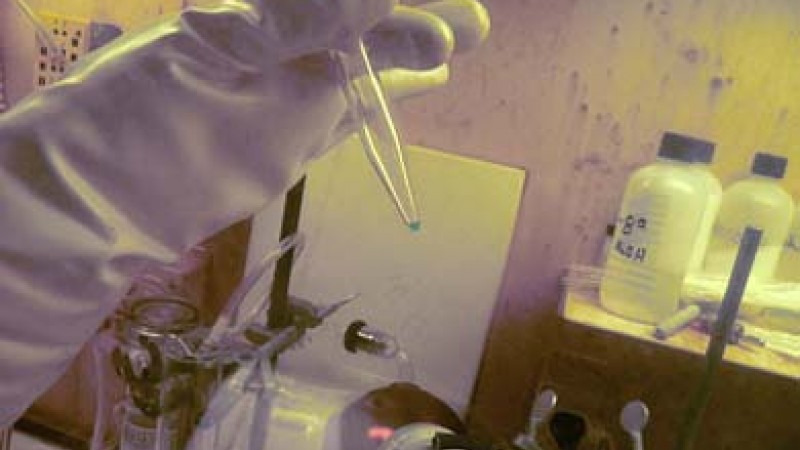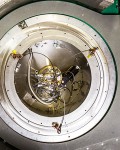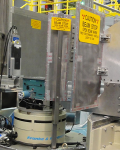The High Flux Isotope Reactor and the Spallation Neutron Source figured in two of the five Gordon Battelle prizes for scientific discovery announced on January 31, 2011. Awards were presented to Oak Ridge National Laboratory teams for the discovery of element 117, which used isotopes created at HFIR, and for groundbreaking studies of iron-based superconductors conducted on triple-axis spectrometers at HFIR and the ARCS (Wide-Angular Range Chopper Spectrometer) instrument at SNS.
The prizes are awarded by Battelle Memorial Institute to recognize the most significant advancements at national laboratories that Battelle manages or helps to manage. Each award includes a $5,000 donation to be made to a school chosen by the team members. Battelle is a nonprofit independent research and development organization based in Columbus, Ohio. ORNL is managed by UT-Battelle, LLC, a partnership of Battelle and the University of Tennessee.
Discovery of element 117. A U.S.–Russian team, including scientists and engineers from ORNL, discovered a new chemical element with atomic number Z=117, the most recent addition to the periodic table. A total of six atoms of “ununseptium” were detected in a two-year campaign employing HFIR and the Radiochemical Engineering Development Center at ORNL and the heavy-ion accelerator capabilities at the Joint Institute for Nuclear Research in Dubna, Russia.
ORNL team members included U.S. project manager James B. Roberto, Krzysztof Rykaczewski, D. E. Benker, J. G. Ezold, C. E. Porter, and F. D. Riley. The team also included researchers from Lawrence Livermore National Laboratory and Vanderbilt University. They selected Meigs County Middle School in Decatur, Tennessee, to receive the school donation.
The discovery of the new element expands the periodic table and understanding of the properties of nuclei at extreme numbers of protons and neutrons. The production of a new element and observation of 11 new heaviest isotopes demonstrate the increased stability of super-heavy elements with increasing neutron numbers and provide the strongest evidence to date for the existence of an island of enhanced stability for super-heavy elements. The long half-lives observed for the neutron-rich daughter isotopes offer the potential for experiments to determine the chemical properties of super-heavy elements. The results are also highly relevant to future super-heavy element discovery experiments, providing critical information on nuclear reaction parameters.
Studies of iron-based high-temperature superconductors. ORNL applied its distinctive capabilities in neutron scattering, chemistry, physics, and computation to detailed studies of the magnetic excitations of iron-based superconductors (iron pnictides and chalcogenides), a class of materials discovered in 2008.
ORNL team members include principal investigator Mark D. Lumsden, Douglas L. Abernathy, Andrew D. Christianson, Clarina R. De la Cruz, Mau-Hua Du, Rongying Jin, Gregory J. MacDougall, Michael A. McGuire, David Mandrus, Herbert A. Mook Jr., Stephen E. Nagler, Athena Safa-Sefat, Brian C. Sales, David J. Singh, and Matthew B. Stone. Researchers from Argonne National Laboratory and the ISIS facility at Rutherford-Appleton Laboratory in the UK also were involved. The team selected Vine Middle Performing Arts and Science Magnet School in Knoxville, Tennessee, for the school donation.
This research is yielding new insights into the relationship between magnetism and superconductivity and has established several key features of this family of high-temperature superconducting (HTS) materials: the maximum magnetic field at which they can function, the nature of the electrons involved in the superconductivity, the dependence of the properties upon chemical substitution, and the character of the magnetic fluctuations in the material. The results suggest that despite important differences between these materials and the HTS copper oxides, a universal mechanism may be responsible for the unconventional superconductivity. HTS materials conduct electricity without resistance at temperatures that make them usable in practical applications and thus have enormous potential for energy efficiency. The emergence of the iron-based superconductors has rejuvenated the field of high-temperature superconductivity.
Published Work: Evolution of spin excitations into the superconducting state in FeTe1-xSex
Contact: Mark Lumsden
The other Gordon Battelle award winners in the category of Scientific Discovery were
- Brookhaven National Laboratory for DNA Guided Crystallization of Nanoparticles
- Brookhaven National Laboratory for Newly Discovered Properties of the Perfect Liquid
- Pacific Northwest National Laboratory for Discovery of Thousands of New Proteins in Spinal Fluid
Gordon Battelle founded the Battelle Memorial Institute in 1929 to promote the application of science and technology to industry. The prize named for him represents two categories: scientific advances in the physical, life, or social sciences that have been published in the last three years, and technology innovations that are on track or have high promise to provide social and economic benefit.














